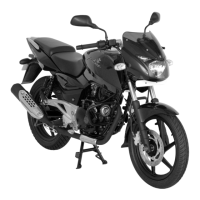GENERAL INFORMATION
Pulsar 150/180 DTS-i
Service Station Manual
10
Dealer Development Center
Akurdi Pune
Tightening Sequence
Generally, when installing a part with several bolts, nuts, or screws,
start them all in their holes and tighten them to a snug fit. Then tighten
them according to the specified sequence to prevent case warpage or
deformation which can lead to malfunction. Conversely when loosening
the bolts, nuts or screws, first loosen all of them by about a quarter turn
and then remove them.
Tightening Torque
Incorrect torque applied to a bolt, nut, or screw may lead to serious
damage. Tighten fasteners to the specified torque using a good quality
torque wrench.
Force
Use common sense during disassembly and assembly, excessive force
can cause expensive or hard to repair damage. When necessary, remove
screws that have a non-permanent locking agent applied using an impact
driver. Use a plastic-faced mallet whenever tapping is necessary.
Gasket, O-ring
Hardening, shrinkage, or damage of both gaskets and O-rings after
disassembly can reduce sealing performance. Remove old gaskets and
clean the sealing surfaces throughly so that no gasket material or other
material remains. Install the new gaskets and replace the used O-rings
when re-assembling.
Liquid Gasket, Non-permanent Locking Agent
For applications that require liquid gasket or a non-permanent locking
agent, clean the surfaces so that so oil residue remains before applying
liquid gasket or non-permanent locking agent. Do not apply them
excessively. Excessive application can clog oil passages and cause
serious damage.
2
3
Tightening
Sequence
2
1
